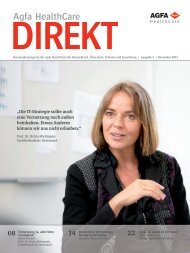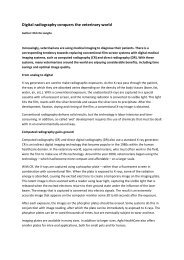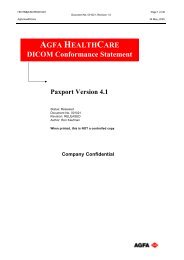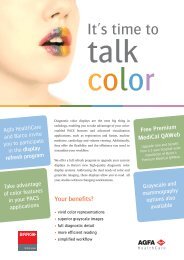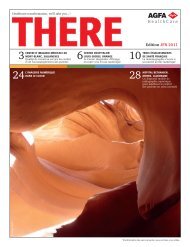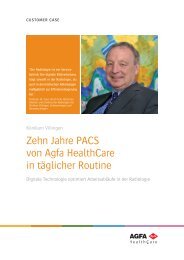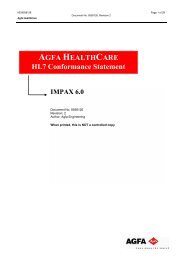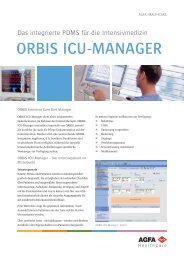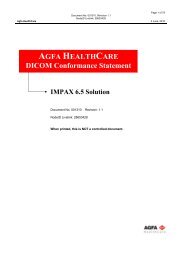Edition 4 - Agfa HealthCare
Edition 4 - Agfa HealthCare
Edition 4 - Agfa HealthCare
You also want an ePaper? Increase the reach of your titles
YUMPU automatically turns print PDFs into web optimized ePapers that Google loves.
MPR (Maximum Intensity Projection/<br />
Multi-Planar Reformat) for daily<br />
routine; registration fusion that fuses<br />
images from different modalities; virtual<br />
colonoscopy applications that automate<br />
the presentation of the colon and assist<br />
in disease screening; and advanced<br />
orthopedic template and measurement<br />
applications that assist in surgical<br />
planning and measure treatment effect.<br />
And these are only a few examples.”<br />
“The clinical applications have had<br />
another important effect: they have<br />
introduced PACS to image-intensive<br />
departments beyond radiology.<br />
An increasing number of cardiologists,<br />
orthopedic surgeons, women’s care<br />
specialists and so forth are using PACS<br />
and its advanced applications for their<br />
specializations. It enables them to deliver<br />
faster, more accurate care.”<br />
What is the next step for PACS<br />
“We are already there. The past<br />
ten years taught us that integration and<br />
data sharing across image-intensive<br />
departments were key to driving more<br />
efficient care. This spilled over into the<br />
broader healthcare enterprise, with<br />
the introduction of integrated Hospital<br />
and Clinical Information Systems<br />
(HIS/CIS) that support both clinical<br />
and administrative needs in a single<br />
package. PACS is an integral part of this<br />
story as it is increasingly integrated with<br />
HIS/CIS solutions. In particular, virtual<br />
and Electronic Patient Records (EPR)<br />
that allow image, administrative and<br />
diagnostic information to be combined<br />
and shared across hospitals, regions<br />
and countries are more accepted and<br />
implemented.”<br />
Is healthcare really moving beyond the<br />
hospital walls What is driving this<br />
“The future of healthcare is being<br />
determined by economics and the<br />
pressures on healthcare providers to<br />
do more with less. The call for cost<br />
containment has led to the creation<br />
of regional and national healthcare<br />
networks in many places. These share<br />
services, resources and infrastructure<br />
to deliver unprecedented healthcare<br />
quality. Canada and the UK have long<br />
been frontrunners in this field, with<br />
their nationwide drives for integrated<br />
healthcare. The US and China have taken<br />
note of the benefits of this approach.<br />
Both markets are implementing concrete<br />
measures to deliver more efficient<br />
healthcare through IT, and both are<br />
focusing on controlling costs, increasing<br />
the reach of care and improving its<br />
overall quality. <strong>Agfa</strong> <strong>HealthCare</strong>’s<br />
significant and successful solutions in<br />
the UK and Canada make us a tried<br />
and tested partner in these large-scale<br />
projects.”<br />
“Our global experience in eHealth<br />
has already benefited US customers,<br />
such as Ochsner Health Systems in the<br />
Southern United States. <strong>Agfa</strong> <strong>HealthCare</strong><br />
successfully connected 7 major hospitals<br />
and 35 associated clinics under one<br />
consolidated solution, providing a<br />
complete view of patient imaging data<br />
across this entire healthcare network.”<br />
PACS has allowed clinicians<br />
to improve processes<br />
(cost, cycle time) and<br />
patient care.<br />
With all of these changes, how do you<br />
manage to keep your customers ahead<br />
of technology<br />
“By maintaining a clear commitment<br />
to our customers, we ensure the<br />
continuity of our solutions over time.<br />
Technologies change, and so do needs.<br />
We understand this well: we are now<br />
on our 6 th PACS generation and 4 th RIS<br />
generation. Healthcare doesn’t stand<br />
still, and it is our job to help our<br />
customers transition to each new level.<br />
We ensure that the installed base has<br />
access to every new product generation<br />
without major upgrades or service<br />
disruptions. For example, many of our<br />
1,400 PACS customers have upgraded<br />
to our 6 th generation PACS in the past<br />
two years. Recently, the Oregon Health<br />
Sciences University in Western United<br />
States completed their upgrade to<br />
IMPAX 6. The new platform and design<br />
allows them to greatly extend their<br />
reach into the healthcare community<br />
and connect healthcare providers with<br />
each other. Our new platforms are also<br />
designed to be more plug-and-play.<br />
The software allows us to develop and<br />
introduce new applications directly into<br />
the existing workflows, for a modular<br />
approach.”<br />
You state that these solutions have<br />
shifted away from being radiologycentric,<br />
but aren’t radiology<br />
departments your key customers<br />
“Our focus continues to be the<br />
efficient management of images<br />
and information – whether for the<br />
radiologist, cardiologist, other specialist<br />
(like nuclear medicine) or referring<br />
physician. Healthcare IT has evolved<br />
from a radiology-centric initiative to a<br />
fully fledged enterprise solution, and<br />
we have evolved alongside. Today, we<br />
provide key components and services as<br />
part of an overall vision for integrated<br />
healthcare IT. IMPAX Data Center, for<br />
example, is a highly scalable medical<br />
image archive that supports industryaccepted<br />
methods for linking patient<br />
records from across a facility. Its support<br />
for IHE Cross Enterprise Document<br />
Sharing (XDS) makes it possible to<br />
consolidate non-imaging data and link<br />
multiple repositories to create the basis<br />
for a national healthcare IT network.<br />
Combined with our proven diagnostic<br />
imaging components, such as IMPAX 6<br />
and IMPAX Cardiovascular, our solution<br />
can be flexibly installed and expanded.<br />
In this way, costs are controlled even as<br />
exam volumes are increasing. We are<br />
also always investing in innovative<br />
viewing technologies to further embed<br />
the image content into the EPR. We<br />
build on our knowledge and experience<br />
from many successful projects around<br />
the world, and can offer our customers<br />
a wide range of important services,<br />
including solution design, data migration<br />
and patient ID integration.”<br />
Technologies change, and<br />
so do needs. We understand<br />
this well: we are now on<br />
our 6 th PACS generation and<br />
4 th RIS generation.<br />
What are the challenges and<br />
opportunities for emerging markets<br />
“Much of our success in introducing<br />
technology into emerging markets is due<br />
to our proven methods of selling and<br />
implementing solutions that fit customer<br />
needs. Our consultancy approach<br />
guides customers to the right solution<br />
configuration and implementation<br />
model. We have built a firm reputation<br />
as the partner of choice for RIS/PACS/<br />
Reporting solutions. For example, in<br />
Latin America <strong>Agfa</strong> <strong>HealthCare</strong> has the<br />
number one market share for RIS/PACS/<br />
Reporting. Annual growth is over 60% in<br />
Chile, Columbia and Brazil, and in 2008<br />
we increased the installed base from ›››<br />
THERE 5



